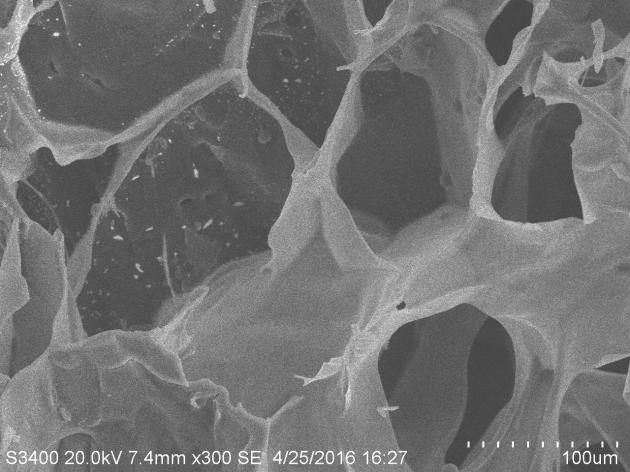一种具有多重响应性水凝胶的制备及其表征毕业论文
2020-06-11 20:56:18
摘 要
近些年来,对于多重相应性水凝胶的研究十分活跃,例如对于温度、pH、氧化还原等。而且智能型水凝胶的研究是一个多重学科交叉应用的实例,也是特别具有挑战性的高新技术领域之一。水凝胶制备成创伤敷料可以减轻传统纱布带来的痛苦,而且效果更好。在这个基础上,本论文通过研究含有双硫键和酰腙键的双响应水凝胶,得要一种有自愈合能力的水凝胶。我们用透明质酸(HA)氧化改性后得到的醛基化透明质酸,rPGA和3,3’-二硫代二丙酰肼改性合成得到的rPGA-S,S’二丙酰肼,把这两种当做凝胶因子,然后通过混合固化的方法制备。本实验研究了该水凝胶的成胶形态、成胶实践、溶胀性能和自愈能力,这就为这种水凝胶材料为应用到医药生物领域提供了指导。
关键词:智能型水凝胶;动态共价键;酰腙键;双硫键;自愈合
Preparation and Characterization of a Multi - responsive Hydrogel
Abstract
In recent years, frequent disasters, due to skin damage caused by infection and even the destruction of the immune system, the final mortality rate increases, the great pain in the treatment process also how to solve the damage caused by skin infection has become the current scientific research The Hydrogel preparation for wound dressings can reduce the pain caused by traditional gauze, and the effect is better. On this basis, this paper studies a hydrogel with self-healing ability by studying the double-reactive hydrogel containing disulfide bond and acylhydrazone bond. We modified with hyaluronic acid (HA) obtained by the modified aldehyde-based hyaluronic acid, rPGA and 3,3'-dithiodipropionyl hydrazine modified rPGA-S, S'-dipropionyl hydrazide , These two as a gel factor, and then by mixing and curing method. In this study, the hydrogel gelation, gelation, swelling and self-healing properties were studied. This provides guidance for the application of this hydrogel material to the field of pharmaceutical biology.
Hydrogel is a number of polymers and copolymers to absorb a lot of water, swelling and crosslinking semi-solid. The nature of the hydrogel is not only related to the properties of the polymeric elastomer and the crosslinker, but also to the conditions of the polymerization process. Depending on the nature of the hydrogel, it is not only related to the nature of the polymeric monomer and the crosslinker, but also to the conditions of the polymerization process, but also on the conditions at the time of swelling. The polymer hydrogel is a kind of cross-linked space reticular polymer having a hydrophilic group which can swell but not dissolve in water. Through its own response to the external environment, the degree of response can be divided into two categories, one is the external response to the intense response of intelligent hydrogels, and the other is not sensitive to the external environment of traditional hydrogels. The important feature of intelligent hydrogels is that when the external environment (such as pH, temperature, light or some chemical substances) to a certain extent to achieve a certain critical conditions, can produce some discrete jump changes, this change Is called volume facies transformation. This material contains the function of sensing, processing and execution, and has some potential applications in the field of cartilage repair, cell smart immobilization, controlled release of drugs, etc., as with certain biomaterials in the organism.
The double sulfide bond of this experiment is an important dynamic covalent bond, which can react to the stimulation of light and redox substances. Acylhydrazone bond is another important dynamic covalent bond, which responds to temperature and pH stimuli, and has obvious advantages over other covalent bonds such as imine bonds. In particular, under acidic conditions, the acylhydrazone bond is more stable, and it is able to achieve a dynamic equilibrium at room temperature under near neutral neutral acid conditions. The two kinds of dynamic covalent bonds do not affect each other, can exist in a common environment, based on the nature of these two covalent bonds, the successful development of this experiment, the two kinds of covalent bond Of a hydrogel containing both a disulfide bond and an acylhydrazone bond, capable of carrying out a multiple response, and the hydrogel has a certain self-healing ability.
Key words:Keywords hydrogel; dynamic covalent bond; acylhydrazone bond; disulfide bond; self-healing
目 录
摘 要 I
Abstract II
目 录 1
第一章 绪论 4
1.1水凝胶 4
1.1.1水凝胶的概念及和生成原理 4
1.1.2 水凝胶的不同分类 4
1.1.3 水凝胶的应用 4
1.2水凝胶制备/交联方法 5
1.2.1 交联方法的类别 5
1.2.2 Schiff Base反应 6
1.3 动态共价键与响应水凝胶的合成 7
1.3.1 动态共价键的概念与简述 7
1.3.2 腙键的合成和交换反应 7
1.3.3 二硫键的合成和交换反应 8
1.4 可逆动态共价键与自愈合材料 8
1.5国内外研究现状 9
1.5.1研究现状 9
1.6 小结 11
第二章 凝胶因子的制备 12
2.1 前言 12
2.2 实验部分 12
2.2.1 药品与仪器 12
2.2.1.1 实验药品 12
2.2.2 水凝胶的合成及影响因素的研究 13
2.2.2.1氧化改性透明质酸(醛基化透明质酸)的合成 13
2.2.2.2 3,3’-二硫代二丙酰肼的合成 14
2.2.2.3 rPGA-S,S’二丙酰肼的合成 14
2.2.3 高分子链的结构特征 14
2.2.3.1 核磁共振分析 14
2.3 结果分析和讨论 15
2.3.1 氧化改性透明质酸(醛基化透明质酸)的合成和结构分析 15
2.3.2 rPGA-S,S’二丙酰肼的合成和结构分析 16
2.4 总结 16
第三章 水凝胶的合成 18
3.1 前言 18
3.1.1 药品与仪器 18
3.1.1.1 实验药品 18
3.1.2 凝胶的合成和研究凝胶合成的影响因素 18
3.1.2.1 双重响应水凝胶的合成 18
3.1.2.2 水凝胶的合成 19
3.1.2.3 pH对水凝胶合成的影响 19
3.1.3 凝胶形成的鉴定 19
3.1.3.1 试管倒置法 19
3.1.4 凝胶的溶胀 20
3.2结果与讨论 20
3.2.1 凝胶的形成鉴定 20
3.2.1.1 试管倒置法 20
3.3.1.2 凝胶因子的质量分数对成胶时间的影响 20
3.3.1.3 pH对于成胶的影响 21
3.3.2 水凝胶的溶胀 21
3.3.3 凝胶的形态 23
3.4 本章小结 24
第四章 双响应水凝胶的响应性和自愈性 25
4.1 引言 25
4.2 实验部分 25
4.2.1 药品与仪器 25
4.2.1.1 实验药品 25
4.2.1.2 实验仪器 25
4.2.2 凝胶的相转变 26
4.2.2.1 水凝胶的pH响应 26
4.3 结果与分析 26
4.3.1 水凝胶的相转变 26
4.3.1.1 水凝胶对酸碱度的响应 26
4.3.1.2 水凝胶的氧化还原响应 27
4.4 水凝胶的自愈合能力 27
4.5 本章总结 28
参考文献 29
第一章 绪论
1.1水凝胶
1.1.1水凝胶的概念及和生成原理
水凝胶(Hydrogel)是一种把水作为分散介质的凝胶态物质[1]。这种高分子网络结构比较柔软,具有一定的形状,还有较强的吸水能力。就是因为结构中含有的这些亲水性或者亲溶剂的基团,能够让它溶胀达到平衡。但是这种溶胀的程度要由交联的密度来决定,溶胀度和交联密度成反比[2]。
1.1.2 水凝胶的不同分类
根据水凝胶由来、大分子构成成分、晶体形态、制备方法、带电状态、交联点性质等类别可以将水凝胶进行如下分类。根据来源分:自然水凝胶:包括胶原、胶质、多糖类化合物(SA、淀粉、琼脂糖、DEX、ALG,HA)等。合成水凝胶:是通过化学交联手段制备得到的水凝胶[3]。如:聚酯,聚磷腈和聚乙二醇PEG。根据构型分:非晶型水凝胶(无定形水凝胶);半晶型水凝胶(晶型和非晶型的混合物);晶型水凝胶。这些年来,高分子水凝胶这个课题已经成为了热门的研究课题,特别是对于不同的外界环境的刺激,像是温度、pH、氧化还原、光照等。
1.1.3 水凝胶的应用
相关图片展示:











